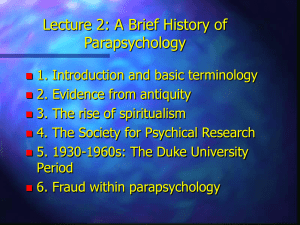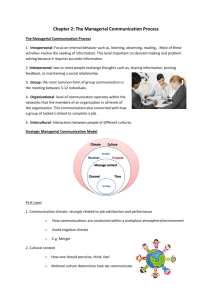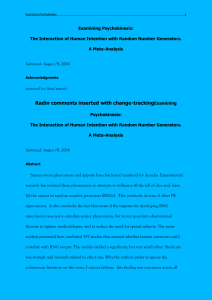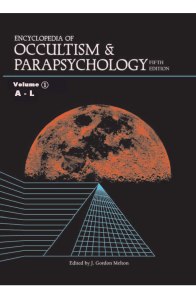Document 9284136
advertisement
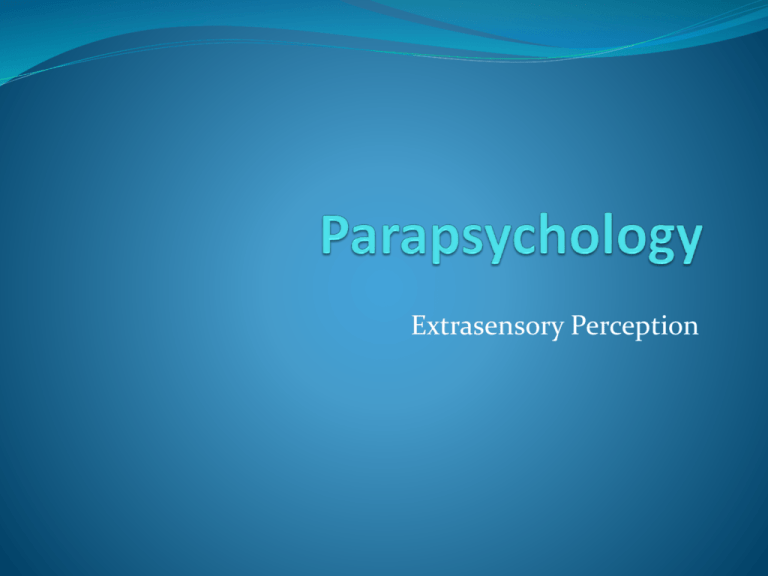
Extrasensory Perception ESP: What is it? Information not gained through the recognized physical senses but perceived by the mind. Term coined to J.B. Rhine (1985-1980) Father of Parapsychology Botanist who became a psychologist Worked at Duke University Founded the Rhine Institute Apply scientific principles to “physical phenomena” Institute still exists but not affiliated with Duke Abilities in Parapsychology Telepathy: mind reading, discerning another thoughts through PSI. Clairvoyance: ability to see things beyond the normal range of vision. Precognition: knowing the occurrence of an event before it happens. Telekinesis: the movement of objects that can’t be explained scientifically. These abilities are testable in lab settings. Other parapsychological study Near-death experiences Ex: case studies of people who have “died” during operations Reincarnation Ex: interviews with young children (3-7) remembering deceased family members Apparitional experiences Ex: ghost hunters Beliefs in USA adults (Gallop 2011) Have had a paranormal experience Believe that ghost are spirits of the dead Psychic or spiritual healing Demonic possession Believe in extrasensory perception Believe that houses can be haunted Channeling (spirit being enters body) 71% 56% 55% 42% 41% 37% 9% Early Psychical Research Society for Psychical Research: London, 1882 Interests: telepathy, apparitions, haunts Spiritualism: communicating with the dead William James was an early supporter of research American Society for Psychical Research: NYC, 1885 William James Believers and skeptics Photography provided evidence of haunts. Or did it? Real or fake? How could you tell? Believer: Sir Arthur Conan Doyle Author of Sherlock Holmes mysteries Also a believer in psychical phenomenon Sent pictures of fairies taken by children Published them in newspaper as being the real thing. http://www.youtube.com/watch?v=zxnhtbaBXJc&feature=related Skeptic: Harry Houdini Escape artist and stage performer Appears in movie as the skeptical voice. Sought our a medium to contact his mother. Unfortunately medium “channeled” his mother as speaking German when she spoke Yiddish. Went on campaign to expose fraudulent mediums. Mediums using tricks to make spirits appear. More recent battle Uri Geller, Psychic James Randi, Magician http://www.youtube.com/watch?v=UB9Hf7ERvXE Need for Control of the Lab JB Rhine aware of the need for controlled experiments Reason for the establishment of lab to test Telepathy: discerning another thoughts. Clairvoyance: ability to see things beyond the normal range of vision. Precognition: knowing the occurrence of an event before it happens. Telekinesis: the movement of objects that can’t be explained scientifically. Zenner Deck Karl Zenner developed system for testing abilities Subjects guess which of five novel symbols was going to appear. Percentage of correct guesses has to be significantly better than chance. 1 out of 5 or 20% most likely outcome by chance. Need to do lots of trials (thousands of them) to determine if ESP actually exists. Rhine and Zenner conducting 90,000 trials on subjects Zenner Test http://www.youtube.com/watch?v=HBJ84RNCXM Criticism of Research Illusionist Milbourne Christopher states that “there are at least a dozen ways a subject who wished to cheat under the conditions Rhine described could deceive the investigator.” For example, early Zenner decks printed on thin paper allowing subject to see the image on opposite side. Also high hit rates early on that fade with further trials. Selective reporting of only positive findings. Need for more careful controls. Does any PSI research stand up? Some skeptic would say that none of it is scientific. Prefer to call in pseudoscientific. In 1988 US National Academy of Sciences concluded that there was “no scientific justification from research conducted over a period of 130 years for the existence of parapsychological phenomena.” Parapsychology remains an isolated inquiry. Only funding comes from private sources. Some believers still exist. Daryl Bem Member of Cornell’s Psych Dept from 1978-2007 Well known researcher in several areas. Personality and sexual orientation. Also conducted experiments in PSI. Best know for remote sending using Ganzfield procedure. Ganzfield A "receiver" is placed in a room relaxing in a comfortable chair with halved ping-pong balls over the eyes, having a red light shone on them. The receiver also wears a set of headphones through which white noise is played. The receiver is in this state of mild sensory deprivation for half an hour. During this time, a "sender" observes a randomly chosen video clip and tries to mentally send this information to the receiver. The receiver speaks out loud during the thirty minutes, describing what he or she can “see”. This is recorded by the experimenter (who is blind to the target). Ganzfield means “entire field” in German. Subject characteristics Transmission is best with subjects who Well known to each other (close friends) Regularly meditate One is sender, the other is the receiver. Sender views video clip. Receiver must select right video clip (1 out of 4). Chance would be 25% Bem reports rates of 35%, statistically significant. Some skeptics not satisfied Susan Blackmore, a paranormal investigator (2001). The only honest reaction to the claims of psi in the ganzfeld is for me to say "I don't know but I doubt it. Skeptics Dictionary (2011). Actually, what we know is that the jury is still out and it probably will never come in if the best that parapsychologists can come up with is a statistic that is unlikely due to chance. What hope do we have of isolating, harnessing, or expanding this power if a person who has it can’t even directly recognize its presence? Do we keep searching?



